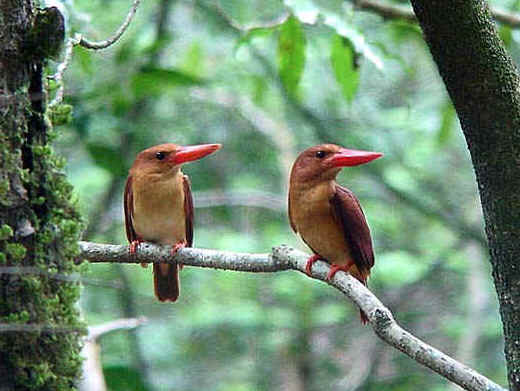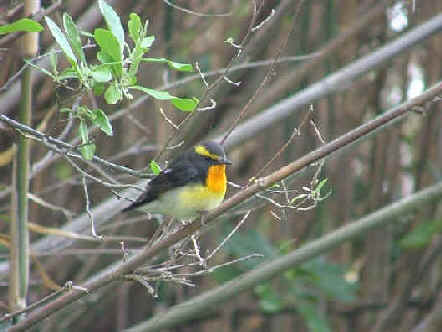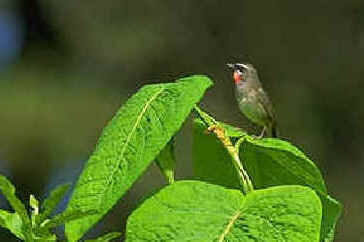
E-mail: font@focusonnature.com
Phone: Toll-free in USA 1-800-721-9986
or 302/529-1876
 |
PO
Box 9021, Wilmington, DE 19809, USA E-mail: font@focusonnature.com Phone: Toll-free in USA 1-800-721-9986 or 302/529-1876 |
THE FOCUS ON NATURE TOUR IN JAPAN
May 2007
"A Tour on 5 Japanese Islands: Honshu, Kyushu, Okinawa, Amami,
and a little island that, in the spring, is a magnet for many birds,
Hegura"

Ruddy Kingfishers
Links:
Birds & Other Wildlife during our Japan Spring Tour - May 2007
Cumulative List of Birds during our Japan Tours (with photos)
Birds during FONT tours on Hegura Island (with photos)
Birds during FONT tours on the island of Amami
Birds during FONT tours on the island of Okinawa
Upcoming FONT Birding & Nature Tours in Japan
The following narrative of the FONT May '07 Japan Tour was written by Armas Hill, leader of the tour:
May is a wonderful month, almost anywhere in the Northern Hemisphere. It's
spring at its best, and, many places, birding at its best as well.
And some of the best birding, it's fair to say, anywhere on Earth in the spring,
is on one very small island in the Sea of Japan, called Hegura.
During the spring of 2007, FONT conducted its 6th tour on Hegura Island, as part
of our annual spring birding & nature tour in Japan. The tour, which took
place May 6-20, 2007, was the 28th FONT tour in Japan, and our 11th there in the
spring. During the tour, we visited 5 Japanese islands.
Two of those islands were the major islands of Honshu and
Kyushu. We also went
to the more-southerly islands of Okinawa and
Amami.
But, the other island we visited was the small one, referred to here in the
first paragraph. Located off the western coast of Honshu, it's called in
Japanese Hegurajima, or simply, as noted in the first paragraph, Hegura.
Although that island is small (one can walk its perimeter in less than an hour),
it was on Hegura that we saw the biggest number of birds: 111 of the 205 species
found totally during the entire 2-week tour.
That tally of 111 species was
our highest there (surpassing the 102 species that we saw in 2004).
Hegura
Island is a place to see not only "Japanese" birds, but also some more
common elsewhere in Asia. Such birds, that are vagrants or rarities in Japan,
and nearly annual for us on Hegura, have included these, seen again
during our tour in '07:
Mugimaki Flycatcher, Swinhoe's Robin, and Tristram's
Bunting.
Other birds more of mainland Asia that we saw on Hegura in '07
were:
Little & Yellow-browed Buntings, Isabelline & Pied
Wheatears, Chinese Grosbeak, Daurian (or Purple-backed) Starling,
Black-naped Oriole, and the avian "star of the show" for the
Japanese birders also on the island when we were, the Black Drongo.

Black-naped Oriole
Also on Hegura Island, we saw 2
Chinese Pond Herons.
Nearby, a day or so earlier, when we were on the mainland of Japan (that would
be Honshu), on the picturesque Noto Peninsula, in a rural area, we saw a Chinese Egret
on a wet ricefield, another Japanese rarity.
From the passenger ferry between the Noto Peninsula and Hegura island, we saw Japanese
Murrelet on the water, and many Streaked Shearwaters in flight. (Yes
it's a passenger ferry. On Hegura, there are no motor vehicles other than 1
small red firetruck and 1 small white ambulance.)
On the southern island of Okinawa (in a forested region called Yambaru), we saw both the Okinawa
Rail and the Okinawa Woodpecker.
The former was "new to
science" in the 1980's. The latter is very rare.
The rail we saw at
dusk our first day on the island.
The woodpecker we saw the next morning
at a nest.
Another very rare bird was seen during our stay on the island of Amami. It's an
endemic, the Amami Thrush.
Also on that island we saw an animal that's
seen only very rarely, the nocturnal Amami Rabbit of the deep forest in
the hills, where also after dark, one night, we encountered at least 25
Ryukyu Scop-Owls. Most of them we heard; a few we saw.
Among the birds that we saw on Kyushu were the Fairy Pitta and the Copper
Pheasant. Both of these are certainly "notables"!
The latter is a
Japanese endemic, as is the Green Pheasant that we also were glad to see
earlier during the tour.
These Japanese pheasants were really 2 of many sightings that we were
happy to have in Japan in the Spring of 2007.

Narcissus Flycatcher
Given thus far, in capsule form, have been some of the highlights of the tour.
Following, now, are some more of the details.
During our 2007 Japan Spring Birding Tour, as
noted 205 species of birds were found. Nearly all of them were seen. Just a few (owls &
nightjar) were heard in the dark of night on either Kyushu or Okinawa
(Oriental & Ryukyu Scops-Owls on the latter).
Cumulatively, during the 11 FONT spring Japan tours, 301 species of birds have
been found, including the following that were "added to the list" in
May 2007:
Falcated Duck
Long-toed Stint
Spotted Redshank
Ural Owl (heard)
House Swift
TREE PIPIT
Bluethroat
ISABELLINE WHEATEAR
PIED WHEATEAR
RADDE'S WARBLER
DAURIAN (or PURPLE-BACKED) STARLING
BLACK DRONGO !!! (THE BIRD of "Japan Spring 2007")
YELLOW-BILLED (or CHINESE) GROSBEAK
Chestnut-eared (or Grey-headed) Bunting
YELLOW-BROWED BUNTING
LITTLE BUNTING
The capitalized birds in the above list were new for ANY Japan tour (9 birds). All of these capitalized birds are rarities in Japan.
Elsewhere in this web-site (from
a link at the beginning of this narrative), there's a list of the birds that
have cumulatively been seen during our 6 tours on Hegura
Island. That list is now up to 172 species.
During May '07, we added 22. They
were:
Little Grebe
Common Ringed Plover
Wood Sandpiper
TREE PIPIT
ISABELLINE WHEATEAR
Meadow Bunting
YELLOW-BROWED BUNTING
LITTLE BUNTING
BLACK DRONGO
YELLOW-BILLED (or CHINESE) GROSBEAK
Chestnut-eared (or Grey-headed) Bunting
Striated Heron
Ruddy Kingfisher
Eurasian Sparrowhawk
Long-toed Stint
"Eurasian" Whimbrel
RADDE'S WARBLER
Varied Tit
DAURIAN (or PURPLE-BACKED) STARLING
Terek Sandpiper
Bluethroat
PIED WHEATEAR
Again, the species in capital
letters were new for ANY FONT Japan Tour.
With the May 2007 tour, the cumulative list of birds during all of the FONT Japan tours is
388 species.
111 species of birds were
tallied during our May 2007 tour on Hegura Island. That's the most we've ever
had during a single visit.
Here's the
breakdown of the number of species we've seen on Hegura over the years:
2001: 72
2002: 56
2004: 102
2005: 74
2006: 88
2007: 111
Our dates on Hegura Island have bee:
2001: April 16-17 (1 night)
2002: May 6-7 (1 night)
2004: May 15-18 (3 nights)
2005: May 19-21 (2 nights)
2006: May 10-12 (2 nights)
2007: May 9-12 (3 nights)
The 2 times that we topped 100 species were the 2 times that we were there 3
nights.

Siberian Rubythroat on
Hegura Island
Here's a note pertaining to another record-high number for us during our May
2007 Japan tour:
There were 12 species of BUNTINGS, 11 of which were on Hegura Island.
The '07 Buntings were:
Grey, Black-faced, Japanese Yellow, Meadow,
Chestnut-eared, Yellow-throated, Yellow-browed, Little, Tristram's, Rustic,
Common Reed, and Japanese Reed.
The last of these was not on Hegura, but on mainland Honshu.
3 of these are
rarities in Japan, being more-common on mainland Asia: the Yellow-browed,
Little, and Tristram's.
2 Buntings not present in 2007 were found, however, during our previous tours on Hegura
Island:
the Chestnut (in 2004), and the Yellow-breasted (in 2004 & 2005).
So, out of 14, this time there were 12, our most for 1 year!
As already notd, Hegura Island, in the Sea of Japan off Honshu, was not the only island that we
visited during our May 2007 Japan tour.
We also went to the more-southerly
islands of Okinawa, Amami, and Kyushu.
We had planned on 3 days on Okinawa in order
to have the time, if we needed it, to find two birds that can be difficult to see.
One of these, the Okinawa Rail, is a
flightless bird of the forest that's only been known to science for a couple
decades. It's shy, and there's a reason why it escaped detection on a mostly
populous island until the 1980's. We saw the species, during May '07, during our
first afternoon on the island. We saw 2 of the rails along the side of a little
road, "out in the country".
The second bird that can be difficult to find is the Okinawa Woodpecker,
one of the rarest woodpeckers in the world. We saw it our first morning in the
forested part of the island where it has a very restricted range. We quietly
watched a parent woodpecker at a nest hole, feeding young. The adult
woodpeckers, during nesting time, are also quiet. More audible were the young
birds in the tree cavity.
Another nice bird to see in Okinawa was the Japanese Paradise Flycatcher.
During a walk in the woods, we certainly enjoyed the adult male, with its long
tail, on a branch above us.
Amami is a Japanese island that's quite
special. Not many visitors go there, to an island "off the beaten
path" as it were, but FONT has a number of times - well over a dozen.
We've
gone, not just because it's a beautiful island covered with forested hills, or
because there's more tradition and less neon lights than in most of Japan, but
because there are some special birds to be seen.
Probably the most notable among
them is the colorful Lidth's Jay. It's endemic to Amami and one very
small nearby island. Colorful, yes, it's a rich chestnut and purple-blue.
There's another specialty of Amami that's not only endemic, but also very rare,
and a skulker - in all, making it a difficult bird to see. It's the Amami
Thrush, and we saw it our first day on Amami, when also we encountered our
first Whistling Green-Pigeons and Amami Woodpecker - the latter
has been considered a distinctive subspecies of the White-backed Woodpecker -
but without very much white on its back. A species, or a subspecies, it's only
on Amami.
Amami is at the north end of a string of small islands known as the Ryukyus.
On the island, we saw the dapper Ryukyu Robin (as we did on Okinawa, further
south in Ryukyus), the Ryukyu Flycatcher (a recent split from the Narcissus
Flycatcher), and one night we encountered about 25 Ryukyu Scops-Owls.
Also that night, at about midnight, in the forest, we came across a Ruddy
Kingfisher perched at about eye-level on a branch. That bird is not only
brightly colorful in then middle of the day. In the light from our vehicle, it
also was brilliant in the middle of the night.
On Kyushu, the southernmost of the main
Japanese islands, our primary avian objective was the beautiful Fairy Pitta,
a bird with seven colors. We saw it.
In that forest, there was another pigeon
and woodpecker duo, as there was in Amami.
It was another Green Pigeon,
the White-bellied. The Woodpecker was the Japanese Green,
an endemic to Japan. And there was another notable Woodpecker in that
forest, the White-backed, with, in this subspecies, white in its back.
In another area of forested hills in Kyushu, birds for us included the brilliant
Oriental Roller and one that could be called a true prize, the endemic Copper
Pheasant!
When the pheasant was seen, It was on a remote road, as it walked slowly, but with determination, into the brush, not to be seen again.
We went back to that remote road again, however, late that night. Along it, we did not
encounter any birds, but we did see as many as 6 species of mammals:
Raccoon
Dog, Red Fox, Sika Deer, Eurasian Wild Boar, Large Japanese Fieldmouse, and True's
Shrew-mole.
Also that night, but elsewhere, we did see a Japanese Scops-Owl, and we
heard Ural Owl and Grey Nightjar.
The Copper Pheasant, just noted on Kyushu, was one of our tour highlights.
But it was mot the only pheasant seen during the tour.
Earlier, on the main island of Honshu,
we enjoyed another pheasant that's also endemic to Japan, the Green Pheasant.
It is, actually, the national bird of Japan. Depicted on their money, the 10,000
yen note, is the female.
But, the male, as the one we saw during our tour, is a wonderful bird to see. Even though it's called the Green Pheasant,
that color is just one of a few in its plumage.
Among other birds we saw on Honshu, notable ones were:
the Long-billed
Plover,
the Marsh Grassbird (an uncommon & local bird that's also been called the Japanese Marsh Warbler),
and attractive male Falcated Ducks.
During our travels, we looked over numerous rice-fields where we did see a
number of birds. Some of these birds we saw many times, such as the Snipe and an
assortment of egrets.
In eastern Honshu, the bird we saw most on
rice-fields was the Pacific Golden Plover.
In western Honshu, the bird we
saw the most on rice-fields was the Black-tailed Gull. Among the more unusual birds we saw
on rice-fields were a flock of Spotted Redshanks
mostly in breeding plumage, and, elsewhere, Grey-headed Lapwing.
But the prize of the
rice-fields was the Chinese Egret (noted earlier) that we found, by itself, on such a field in
rural, western Honshu on the Noto Peninsula. That species is a rarity in
Japan, and is actually, a rather uncommon bird, overall.
We experienced another unusual sighting on the Noto Peninsula when, as we were
driving after dark,
a Eurasian Badger crossed a country road in front of us.
Given here have been just some of our notable sightings and experiences during 2
weeks in Japan. Mostly mention has been made of birds and animals - the nature of Japan, but
we also saw and experienced the culture of the country, in so many ways, including the
food, the places, and the people.
We had a wonderful tour, in May 2007 in Japan.
***********************************
After returning home, an e-mail was received by FONT from one of the
people we met in Japan, Mr. Shogo Matsui, who was one of the authors of the bird
book that we've used in Japan for so many years, "A Field
Guide to the Birds of Japan" (in English), published by the Wild Bird
Society of Japan in 1982 .
Parts of that e-mail, and one in response to him by Armas Hill, follow:
Sent from Japan 5/13/2007, from Japan:
"Dear Mr. Hill,
It was my pleasure meeting you
at Hegura-jima birding. We were all deeply impressed watching you and your tour
members so eagerly, actively, and joyfully watching the birds. You are so
energetic and active and have excellent knowledge of birds, and I would say you
are really doing fine as a birding guide.
I think you've seen more birds than we did. I have not come up with the final
figure but it is about 100 species, including 5 lifers for me.
We have returned home safely last night, after driving some 550km, stopping at
another good spot in Nagano Prefecture.
I hope you enjoyed the rest of you tour, and made it home safely.
With best regards
Shogo Matsui"
In response to Mr. Matsui's (or Matsui-san's) e-mail
(in part):
"Hello Shogo Matsui,
Thank you so very much for the
nice e-mail message that I found from you when I returned home from Japan (just
over a week ago). And it was so very good to meet you when we were in Japan,
visiting Hegura Island.
On the left-side of the home-page in the FONT web-site, the list of birds during
our tour can be found from the link under "past tour highlights -
2007".
The number of birds that we saw on Hegura was 111. That's not much more than the
100 or so birds that you saw - 5 of which were "lifers" for you. By
the way, during my visit to Hegura-jima in May 2007, 7 species were
"lifers" for me.
The only bird that I think I forgot to tell you about (when I was there) was a
Pied Wheatear that I saw in the corner of the island not far from the minshuku
where we stayed. The
Isabelline Wheatear we saw was at the other end of the island. And, of course,
it looked different.
Another "lifer" for me
was you. It was such an honor to meet one of the authors of the Japanese bird
book (in English) that I bought and valued so much many years ago - in the
1980's - when I first started birding in Japan. By myself, in those days, I
traveled around the country, looking for birds!
By now, I've done bird-watching in Japan nearly 35 times. During 28 of those
visits in Japan in more than 15 years, I have been bringing other bird-watchers
with me, as I've been leading tours there.
I've watched those bird-watchers so many times as they have been thrilled to see
the birds such as the cranes, eagles, and Blakiston's Fish-Owl, in addition, of
course, to the wonderful birds in the spring on islands such as Hegura, Amami,
and Okinawa.
Very best regards,
Armas Hill"